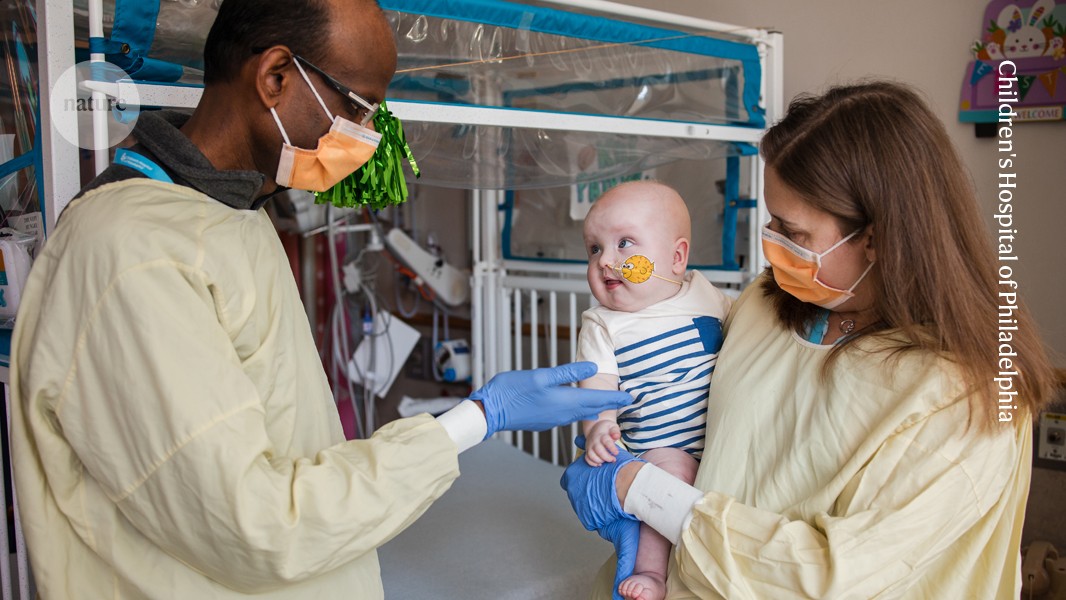World’s first personalized CRISPR therapy given to baby with genetic disease

Treatment seems to have been effective, but it is not clear whether such bespoke therapies can be widely applied

Baby KJ Muldoon, who was born with a genetic disease that affected his ability to metabolize proteins, is the first person to receive a bespoke CRISPR treatment. Credit: Children's Hospital of Philadelphia
A baby boy with a devastating genetic disease is thriving after becoming the first known person to receive a bespoke, CRISPR therapy-for-one, designed to correct his specific disease-causing mutation1.
Little KJ Muldoon, now nearly ten months old, is doing well after receiving three doses of a gene-editing treatment to mend a mutation that impaired his body’s ability to process protein, his parents told reporters this week. But it is too soon to use the word “cure”, says Rebecca Ahrens-Nicklas, a paediatrician at Children’s Hospital of Philadelphia in Pennsylvania, and one of Muldoon’s physicians. “This is still really early days,” she says. “We know we have more to learn from him.”
To reach this point, an international team of clinicians and researchers in industry and academia, with support from US government funders and regulatory agencies, raced to develop Muldoon’s therapy in a mere six months. Yet, the drug that it developed, described in the New England Journal of Medicine on 15 May, is specific to Muldoon’s genetic sequence and will probably never be used for another person, says Ahrens-Nicklas.
It’s an ambitious approach that researchers hope will inspire others to harness CRISPR to treat ultra-rare genetic diseases. “This truly is the future for all of these gene and cell therapies,” says Arkasubhra Ghosh, who studies gene therapy at Narayana Nethralaya Eye Hospital in Bengaluru, India, and who was not involved in the study. “It’s really exciting.”
Early illness
Dozens of people have received CRISPR-based therapies for genetic conditions such as sickle-cell anaemia, but those treatments were designed to be used in many people with the same disorder, regardless of the underlying mutations that caused it. By contrast, researchers tailored Muldoon’s therapy to correct a specific genetic sequence in his genome.
Muldoon had inherited two mutations, one from each parent, that meant that he did not produce the normal form of a crucial enzyme called carbamoyl phosphate synthetase 1 (CPS-1). This compromised his ability to process the nitrogen-containing compounds produced when the body breaks down protein. As a result, his blood had high levels of ammonia, a compound that is particularly toxic to the brain.
The best treatment for CPS-1 deficiency is a liver transplant, but it would be months before Muldoon became eligible. Meanwhile, each day brought added risk of brain damage or death: only about half of babies with severe CPS-1 deficiency survive long enough to receive a transplant.
Ahrens-Nicklas decided to offer the family another option. She and her colleagues had been working with a CRISPR-based technique called base editing, which can make targeted, single-letter changes to DNA sequences. The team was developing ways to quickly and safely tailor a base-editing therapy to correct an individual’s particular mutations. Perhaps now it was time to try the approach in humans, she thought.
With the approval of Muldoon’s parents, the researchers enlisted a lengthy roster of collaborators. The team quickly screened for the best base-editing approach and tested it in mice and monkeys. Companies donated proprietary expertise and components. The US Food and Drug Administration fast-tracked its evaluation of the treatment.
Enjoying our latest content?
Login or create an account to continue
- Access the most recent journalism from Nature's award-winning team
- Explore the latest features & opinion covering groundbreaking research
or
Sign in or create an accountdoi: https://doi.org/10.1038/d41586-025-01496-z
This story originally appeared on: Nature - Author:Heidi Ledford


















